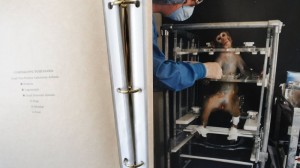“It’s sad that I’m only 23 but animal death doesn’t do anything for me,” says one former research scientist early on in Karol Orzechowski’s Maximum Tolerated Dose. The title itself refers to lab experiments in which animals (or “research models”) are dosed with pharmaceutical products and certain chemicals in order to find a physical threshold. However, while many of these scientists have already proven the efficacy of the product, they repeatedly test high concentrations of certain medicines on lab animals until a fatality or a near fatality occurs.

There are in fact, several facilities specifically designed and created to breed animals such as rodents, macaque monkeys, and even beagles, all in order to supply experimental research. Thus, many of these animals, including monkeys and dogs, are brought into the world for the sole purpose of being used for scientific experiments.
The film does a convincing job in recreating the horrors of such aforementioned animal breeding facilities. For example, the Isoquiem-Interfauna Breeding Facility in Spain specifically breeds beagles, who remain packed in cages all throughout the day, as their cries for help can be overheard echoing in the background, cries which seem to be desperate and helpless.
In one particular experiment, beagles were used to research radioactive tracers, which were injected into them. Afterwards, the dogs were all put down, placed on the operating table, as their hearts were removed and dissected in order to inspect the effects of the tracers.
Dr. John Pippin, a former research cardiologist admits that, “if you subscribe to the notion that this kind of research is essential to advance human medicine, and your career and your life revolves around advancing human medicine, then you come to see it as a necessary evil.”
The sad irony in Dr. Pippin’s story is his own love of dogs. He admits that he would consider killing anyone who would dare hurt his dogs at home, and yet, he consistently went to work every day as a scientific researcher where killing beagles was part of his job.
Orzechowski, known more for his photography, manages to locate and interview a handful of former lab workers and authors on the subject of animal cruelty. The film is told in five separate chapters, as the director focuses on individual lab animals and individual former workers for each segment.
The pulsating, ominous music heard throughout the film has an almost frightening effect. If there is such a thing as a ‘non-fiction documentary horror,’ that which is unimaginable and revolting, then Maximum Tolerated Dosage is it. In addition, the heavy sense of guilt felt by nearly everyone interviewed in the film is accentuated by years of moral justifications on the part of these workers.
An anonymous worker simply puts it, “To the animals, I feel horrible. I could only say that I’m sorry and I will advocate to change this industry.”
It’s never too late to say you’re sorry.
Maximum Tolerated Dosage screens Monday Nov. 4 at 7 p.m. in room H-110 – 1455 de Maisonneuve W. Director Karol Orzechowski will be in the audience. For more information, visit cinemapolitica.org/concordia




